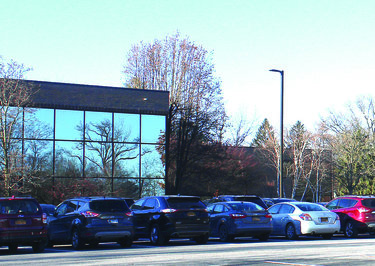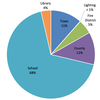Is a costly turning lane required if Great Oaks Office Park adds 120 apartments?
GUILDERLAND — The preliminary approval of the Rosenblum Companies’ plan to add apartments to Great Oaks commercial office park has been put on hold until the Guilderland Planning Board receives additional guidance from the town board on the project.
The proposal is for a 120-unit Planned Unit Development, which requires a rezone through the passage of a new local law. The town board is the lead agency on PUD applications.
The site, which is off Church Road, just west of the Northway, and to the south of Western Avenue, is located within a Business Non-Retail Professional, or BNRP, zone.
The project would add two new apartment buildings to the existing Great Oaks complex, which now consists of three office buildings.
One of the proposed apartment complexes would be five stories tall, with 78 apartments, and 124 underground parking spaces. It would also have amenities to serve both residents and office tenants, including a market/café, a fitness room with showers, bicycle storage, and an outdoor patio.
The other apartment building would be four stories high and contain 42 units, with 32 parking underground parking spaces.
At its June 24 meeting, the planning board was asked by the town board to “make a decision on what improvements, if any, will be required at the Church Road/Western Avenue intersection and Church Road/Great Oaks Boulevard entrance,” according to Town Planner Kenneth Kovalchik’s memo to the board.
The planning board was in relative agreement about the project but could not commit to asking Rosenblum to spend what the company said could be as much as $20,000 for an analysis that could help it make its recommendations on what traffic improvements may be required.
However, it was relieved from having to make that request when Supervisor Peter Barber texted Kovalchik during the virtual and broadcasted meeting to tell him the town board would offer further guidance to Rosenblum at its July 7 meeting.
The planning board would then meet on July 8 to make its recommendation to the town board. Should the planning board offer its preliminary approval of the development plan, the application would go back to the town board for a public hearing and State Environmental Quality Review Act declaration. The application would then come back to the planning board with comments for final approval.
The town board is trying to determine if a turning lane is needed at the intersection of Church Road and Western Avenue to the entrance of Great Oaks Office Park or if changes need to be made only at the entrance of Great Oaks or if no traffic improvements are needed.
Rosenblum made the case that nothing needs to be done and said the town-designated engineer agreed with that assessment.
The turning lane could cost hundreds-of-thousands of dollars, the board was told.
The town-designated engineer had reviewed the Rosenblum-supplied traffic study and said there would be no impact based on the number of trips that the new use would generate; therefore, no mitigation would be necessary.
However, the planning and town boards were looking to see if a possible improvement could be made “despite the fact that there is no degradation in level of service,” Chairman Stephen Feeney said.
The town-designated engineer on June 23 made a request that Rosenblum provide the town with additional modeling, which it said would help the boards better determine if improvements were needed.
A representative for Rosenblum said the scope of the analysis that the town-designated engineer was looking for has already been covered in the original traffic study, and that the analysis the town’s engineer is asking for “is really just expanding it to include that McDonald’s driveway.”
The analysis would end up helping McDonald’s more than Rosenblum, the representative said, but Feeney said it would help the town make its decision.
Kovalchik explained later in the meeting, “I think the purpose of [making the request] is that there’s been traffic studies done; we know what the level of service is there. For some of these unanswered questions, the town board doesn’t want to base it on anecdotal evidence, which we’ve been hearing a lot tonight.”
Rather, Kovalchik said, the town board wants to base its decision on the information requested by its engineer “to get an understanding of a cost-benefit analysis, for lack of a better word: Do these improvements justify being done for the 120 units?”
Feeney drew a distinction between the traffic study Rosenblum provided and the information the town board is looking for.
The original analysis was performed for the State Environmental Quality Review Act, Feeney said, recounting the type of question asked during the review: “Are you causing any impact by the additional trips?”
Feeney said he thought the town board’s conclusion was, “No that additional trips do not warrant any additional improvements at the intersection. And what I’m hearing is a different analysis: Well yeah, we’re not looking at the warrants, we’re saying, ‘If you did this, would it improve the situation?’”
If Rosenblum had been before the planning board seeking special-use permit and site-plan approval, the traffic improvement would be a tough condition to impose, but since it’s a legislative decision — a Planned Unit Development requires rezoning through the a new local law — Rosenblum could be asked to install the turning lane.



